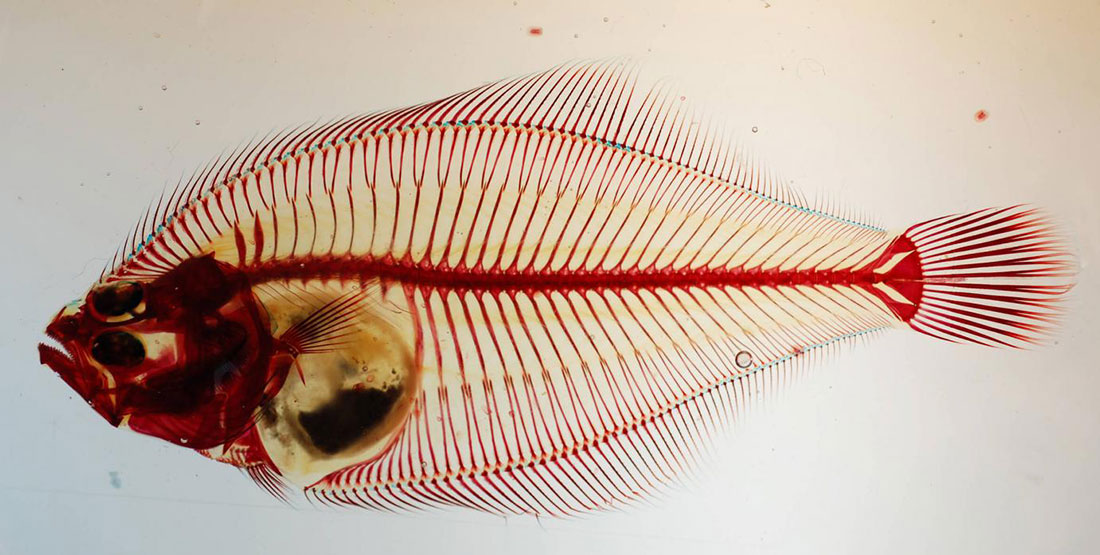2) An adventurous shark
This beautiful Leopard Shark (Triakis semifasciatus) was found in Samish Bay, Washington, making it the northern-most record for this species (the range had previously been documented from Oregon to the Gulf of California). This species is commonly found in shallow waters of bays and estuaries and females can have as many as 24 pups in one litter (shark babies are called pups).
3) A fish with a fishing pole
This specimen of the deep-sea anglerfish Diceratias pileatus was sucked up from 1,000 meters by a big pipe off the coast of Hawaii (which is why it is in such good condition). Anglerfishes have modified dorsal fins with bioluminescent (light-producing) bacteria living in their tissue. The fin acts as a fishing pole attached to their heads with a lure at the tip that mimics other bioluminescent animals such as squid or jellies that are found in the deep ocean. The anglerfish lures larger fish to her—attracted by what looks like prey—then she quickly engulfs the fish with her large mouth and sharp teeth. Anglerfish have been known to eat fish larger than themselves thanks to their greatly expandable stomachs. Food is scarce in the deep sea, so it makes sense to be able to eat whatever you can get your mouth around!
4) Parasitic males
Anglerfishes are not only known for their bioluminescence: they also have an amazing mode of reproduction called sexual parasitism. Male anglerfishes are tiny compared to the females and they attach themselves to the female with specialized teeth—some become completely fused to the female for the rest of their lives. Once attached, their circulatory systems merge and the male’s internal organs degenerate since he now gets all of his nutrients from the female. The fused male and female are now free to reproduce. Finding a mate in the deep ocean is very difficult, so this incredible adaptation ensures that once the male and female find each other that they will remain together, able to reproduce repeatedly. Fun fact—the all-time record is eight males attached to one female!
5) A fish with some scary chompers
Deep waters of the ocean harbor some frightening-looking fish species. This Alepisaurus ferox, or Longnose Lancetfish, has 2–3 centimeter-long daggerlike-teeth on the roof of its mouth and in its lower jaw. It is known to be a voracious predator and eats a variety of fish and invertebrates. These fish grow to be over two meters long, are found in all of the world’s oceans at depths as great as 1,800 meters, and are hermaphrodites (they have both male and female reproductive organs!).
6) A freeloading shark sucker
The various fins of fishes have gone through amazing adaptations through time. This remora (family Echeneidae) has a modified dorsal fin that acts like a suction cup. It can attach itself to the sides of sharks and other large marine animals to catch a free ride, but does not hurt the host in the process. This commensal relationship benefits the remora by providing transportation and protection as well as access to leftover food eaten by the host, while the host benefits from the remora eating its parasites.
7) A fish that sucks
Pelvic fins can also be modified in interesting ways. This Pacific Spiny Lumpsucker (Eumicrotremus orbis) has fused pelvic fins that form a suction cup. They attach themselves to rocks and algae to hold on in fast-moving water (since their golf ball body shape makes them poor swimmers unable to withstand swift currents). This has to be the cutest fish ever.
8) A fish with “migrating” eyes
Flatfishes—such as halibut, sole, flounder—swim upright like other fish when they're born, but as they develop they flop over on their side and one eye moves up and over the head to the other side, so they end up with two eyes on one side and none on the other! They spend the rest of their lives swimming on their side. The flatfish pictured here (Citharichthys stigmaeus) shows both eyes on one side of this beautifully stained specimen (the staining process involves an enzyme turning the skin and muscle transparent, while the bones are stained red and the cartilage is stained blue).
9) Fish nabbed by border patrol
Seahorses are endangered species and their use in aquariums and international trade is closely monitored. These dried specimens were confiscated at the border from people trying to bring them into the country illegally. (You cannot transport fish or wildlife across international borders without the proper permits and declarations.)
10) Fish that look nothing like their parents
We have millions of larval fish specimens in our collection, and most of them look nothing like the adults of their species. Larval fish develop special adaptations to live in plankton, like the stalked eyes found on this Slender Blacksmelt (Bathylagus pacificus). As they mature, fish can go through amazing changes to reach their adult form. In many cases, larval fish were described as separate species from their adult forms because people couldn’t imagine what the larvae grew up to be.

A Slender Blacksmelt (Bathylagus pacificus) larval specimen.

A Slender Blacksmelt (Bathylagus pacifics) adult specimen.
With so many new species of fishes being discovered all of the time, and a constantly growing research collection, I'm sure we'll soon have more weird fishes to add to this list!
---
The Burke Museum Ichthyology Collection maintains a large archival collection of more than 11 million preserved fish specimens from around the world but primarily from the North Pacific Ocean and Bering Sea, and from freshwater habitats of the Pacific Northwest.
See a deep-sea anglerfish, albino ratfish, the two-headed shark, and more unusual specimens in this UW 360 video highlighting the Burke’s fish collection.










